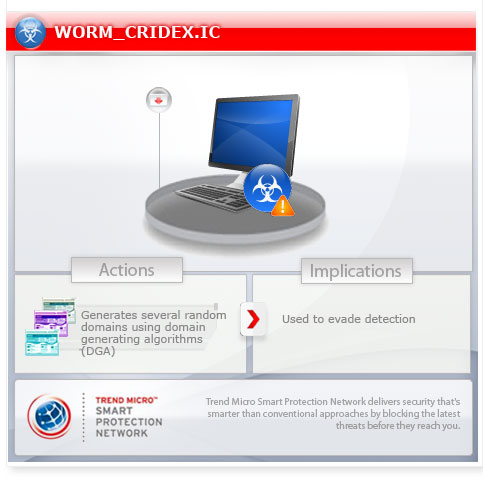WORM_CRIDEX.IC
Windows 2000, Windows XP, Windows Server 2003


Threat Type: Worm
Destructiveness: No
Encrypted: No
In the wild: Yes
OVERVIEW
Dropped by other malware, Downloaded from the Internet, Via removable drives, Propagates via removable drives
This malware intercepts browser requests and changes the displayed content according to the configuration, written by the administrator of the botnet. This way, cybercriminals can trick users into entering valuable information without raising suspicion. It was also found to generate several random domains using domain generating algorithms (DGA).
To get a one-glance comprehensive view of the behavior of this Worm, refer to the Threat Diagram shown below.

This worm arrives via removable drives. It arrives on a system as a file dropped by other malware or as a file downloaded unknowingly by users when visiting malicious sites.
It drops copies of itself into all the removable drives connected to an affected system. It drops an AUTORUN.INF file to automatically execute the copies it drops when a user accesses the drives of an affected system.
It deletes the initially executed copy of itself.
TECHNICAL DETAILS
74,240 bytes
EXE
Yes
17 Mar 2012
Downloads files
Arrival Details
This worm arrives via removable drives.
It arrives on a system as a file dropped by other malware or as a file downloaded unknowingly by users when visiting malicious sites.
Installation
This worm drops the following copies of itself into the affected system:
- %User Profile%\Application Data\KB{Random Numbers}.exe
(Note: %User Profile% is the current user's profile folder, which is usually C:\Windows\Profiles\{user name} on Windows 98 and ME, C:\WINNT\Profiles\{user name} on Windows NT, and C:\Documents and Settings\{user name} on Windows 2000, XP, and Server 2003.)
It creates the following folders:
- %User Profile%\Application Data\E6D62C1B
(Note: %User Profile% is the current user's profile folder, which is usually C:\Windows\Profiles\{user name} on Windows 98 and ME, C:\WINNT\Profiles\{user name} on Windows NT, and C:\Documents and Settings\{user name} on Windows 2000, XP, and Server 2003.)
It injects threads into the following normal process(es):
- Explorer.exe
Autostart Technique
This worm adds the following registry entries to enable its automatic execution at every system startup:
HKEY_CURRENT_USER\Software\Microsoft\
Windows\CurrentVersion\Run
KB{Random Numbers}.exe" = "%User Profile%\Application Data\KB{Random Numbers}.exe"
Other System Modifications
This worm adds the following registry entries as part of its installation routine:
HKEY_CURRENT_USER\Software\Microsoft\
Windows\CurrentVersion\Internet Settings
GlobalUserOffline = "0"
It adds the following registry keys as part of its installation routine:
HKEY_CURRENT_USER\Software\Microsoft\
Windows Media Center\4A5BC09B
HKEY_CURRENT_USER\Software\Microsoft\
Windows Media Center\E6D62C1B
Propagation
This worm drops copies of itself into all the removable drives connected to an affected system.
It drops an AUTORUN.INF file to automatically execute the copies it drops when a user accesses the drives of an affected system.
The said .INF file contains the following strings:
[autorun]
open={Malware File Name}.exe
shell\Open\Command={Malware File Name}.exe
shell\Open\Default=1
shell\Explore\Command={Malware File Name}.exe
shell\Autoplay\command={Malware File Name}.exe
Other Details
This worm deletes the initially executed copy of itself
NOTES:
This worm attempts to establish a connection to the following remote site:
- http://{Random URL}.ru:8080/rwx/B2_9w3/in/
Once a successfully connected, this worm may download its configuration file from its C&C server.
This worm uses a domain generation algorithm to generate random domains.
SOLUTION
9.200
8.846.01
17 Mar 2012
8.847.00
18 Mar 2012
Step 1
For Windows XP and Windows Server 2003 users, before doing any scans, please make sure you disable System Restore to allow full scanning of your computer.
Step 2
Restart in Safe Mode
Step 3
Delete this registry value
Important: Editing the Windows Registry incorrectly can lead to irreversible system malfunction. Please do this step only if you know how or you can ask assistance from your system administrator. Else, check this Microsoft article first before modifying your computer's registry.
- In HKEY_CURRENT_USER\Software\Microsoft\Windows\CurrentVersion\Run
- KB{Random Numbers}.exe = "%User Profile%\Application Data\KB{Random Numbers}.exe"
- KB{Random Numbers}.exe = "%User Profile%\Application Data\KB{Random Numbers}.exe"
- In HKEY_CURRENT_USER\Software\Microsoft\Windows\CurrentVersion\Internet Settings
- GlobalUserOffline = "0"
- GlobalUserOffline = "0"
Step 4
Delete this registry key
Important: Editing the Windows Registry incorrectly can lead to irreversible system malfunction. Please do this step only if you know how or you can ask assistance from your system administrator. Else, check this Microsoft article first before modifying your computer's registry. Before you could do this, you must restart in Safe Mode. For instructions on how to do this, you may refer to this page If the preceding step requires you to restart in safe mode, you may proceed to edit the system registry.
- In HKEY_CURRENT_USER\Software\Microsoft\Windows Media Center
- 4A5BC09B
- 4A5BC09B
- In HKEY_CURRENT_USER\Software\Microsoft\Windows Media Center
- E6D62C1B
- E6D62C1B
Step 5
Search and delete this folder
- %User Profile%\Application Data\E6D62C1B
Step 6
Search and delete AUTORUN.INF files created by WORM_CRIDEX.IC that contain these strings
[autorun]
open={Malware File Name}.exe
shell\Open\Command={Malware File Name}.exe
shell\Open\Default=1
shell\Explore\Command={Malware File Name}.exe
shell\Autoplay\command={Malware File Name}.exe
Step 7
Restart in normal mode and scan your computer with your Trend Micro product for files detected as WORM_CRIDEX.IC. If the detected files have already been cleaned, deleted, or quarantined by your Trend Micro product, no further step is required. You may opt to simply delete the quarantined files. Please check this Knowledge Base page for more information.
Did this description help? Tell us how we did.


